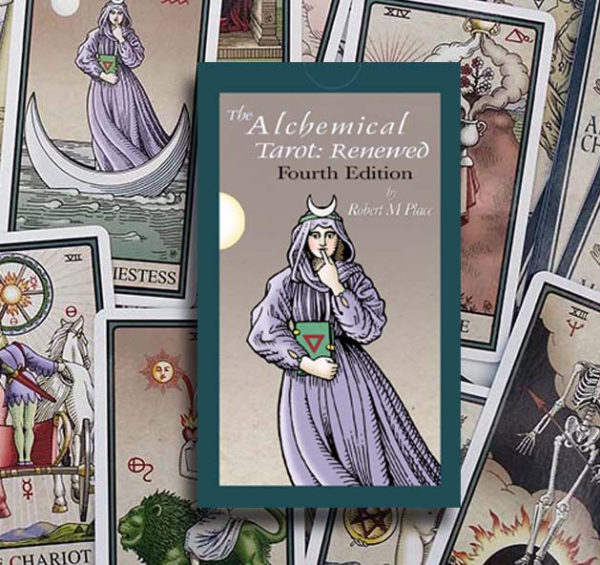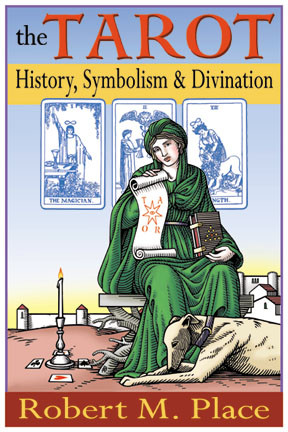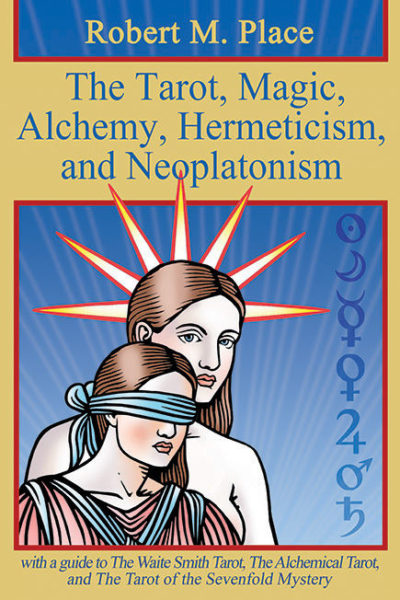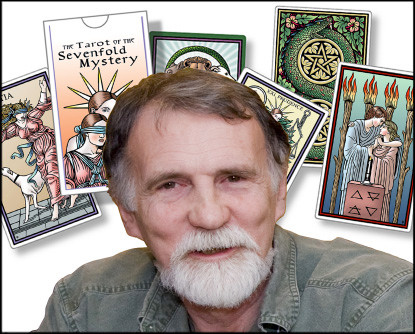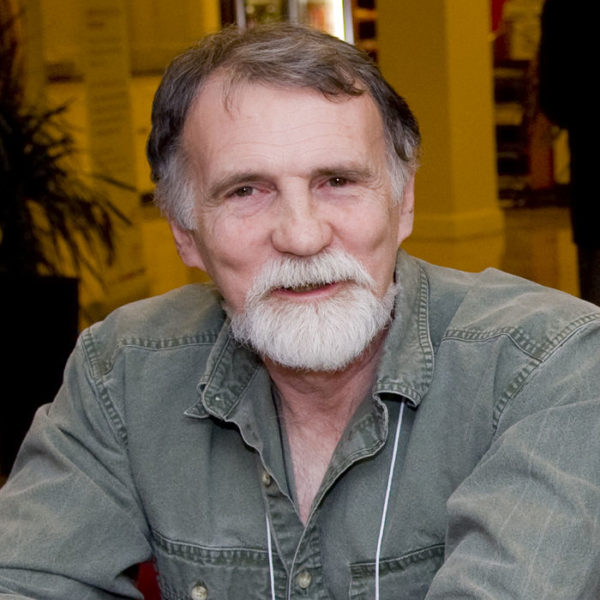
Robert M. Place
I have to admit that at 680 pages and weighing three and a half pounds this is a hefty book. And when we consider that most books on the Tarot are fewer than 300 pages, you may be wondering why I would have so much more to say on this subject than most people. So let me explain how I view the Tarot and how the Tarot came to me.
I often tell people that I did not choose to become involved in the Tarot; actually, it chose me. I have always considered myself an artist, and as an artist, I am drawn to dream-like imagery. As a natural development of that interest, I began paying more attention to my dreams. The dream that I had in the summer of 1982, however, was not like any other that I had before. In the middle of that dream, a dream phone rang, interrupting the storyline of the original dream. When I answered the phone, I was connected to a dream law firm, and a woman at the firm told me that I had an inheritance coming from an ancestor, who had lived in England. She also told me that it would come in a box from England, that it is called “the Key,” and that I would know it when I saw it.
Shortly after that night, a good friend came over—with his new deck of Tarot cards in hand. It was the famous deck designed in 1909 by Pamela Colman Smith, and my eyes were drawn to this deck as if my brain no longer controlled them. Although I was not unfamiliar with The Waite Smith Tarot, I now saw it in a new light—I knew that this was my inheritance. Within a few days another friend, without any prompting, gave me a copy of the Tarot of Marseilles. He just said; “I had a feeling that you needed a Tarot deck.” That was my first deck. I soon went to Manhattan to buy my second deck, The Waite-Smith Tarot.
Realizing that the Tarot was my gift from the dream world, I realized that the cards were tools for creating a message in pictures that could be interpreted as a waking dream. But to interpret these dreams I needed to know more about these images. I wanted to know them as I would want to know a new friend, by asking him or her about his or her past experiences. With the cards, this meant I wanted to know who were the artists who created these images and what they intended to communicate.
Most of the books on the Tarot at that time claimed that the Tarot was an ancient mystical text that originated in ancient Egypt, Morocco, Medieval Europe, or was simply of unknown origin. The creators were said to be wise sages, a group of magicians, or ancient Kabbalists. Because of my knowledge of art history, I knew that these assertions could not be true. It took me several years to piece together a more accurate history. I found some scholarly accounts of the history of the cards in the works of Michael Dummitt, Ronald Decker, and Gertrude Moakley. Now I learned that artists living in northern Italy in the 15th century created the Tarot. From there, it moved to France and was discovered by occultists late in the 18th century. It was at that time that the false narratives began to emerge.
The scholarly histories, especially Dummitt’s, focused on the fact that the Tarot was designed to play a card game that is the ancestor of bridge (this is why his first book on the subject was titled The Game of Tarot). Much later, in 1996, Dummitt teamed up with Decker, and Thierry Depaulis and wrote two books on the occult Tarot, but these books treat the occult decks and the original Renaissance decks as two separate things. Even with these books, there was little effort in Dummitt’s work to uncover the symbolism of the original decks. Moakley was better at this. She saw that the images related to Renaissance culture and to imagery from the triumphal parades that were popular in Italy in the Renaissance. But from my studies of alchemy, Hermeticism, and Neoplatonism, I could see that there was more to the original Tarot trumps. I could see that they described a mystical journey that related to these subjects. In fact, these subjects were prevalent in Renaissance Italy and had an influence on all of the arts at that time. I believed that although the occultists had created numerous false histories and correlations for the Tarot, their basic belief that the Tarot described a mystical path to enlightenment was true, and I set out to explain and verify my insight.
The Creation of my First Tarot
A breakthrough came in the summer of 1987. I was studying an alchemical image that symbolized the Philosopher’s Stone. I had been studying alchemy for some time and I was well aware that the Stone was a mystical substance, whose creation was the central purpose of the alchemical quest, known as the Magnum Opus. Alchemists stipulated that the Stone is not actually a physical substance; it is “the stone that is not a stone. It is composed of a spiritual essence, known as the Anima Mundi. Although it is nonmaterial, the Stone has the power to transform any substance into its highest form. It can turn lead into gold; it can cure any illness; and it can transform an ordinary man or woman into an enlightened sage.
Because it is nonmaterial, alchemists created mystical diagrams, what we now call mandalas, to portray it. The image I was studying in 1987 depicted a heart, surrounded by a thorny wreath, and placed in the center of a cross. The cross framed images of the four elements, one to each corner. This type of mandala is called a quincunx.
Although I had seen images like this before, this time it was different. The image seemed to unlock a secret portal in my mind and in an instant I saw that it was symbolically interchangeable with the Tarot’s final trump, the World. In a flash, I realized that if the Tarot’s series of twenty-one trumps, from the Magician to the World, culminated in this image, which symbolized the Anima Mundi and could be linked to the final result of the Opus, then the whole series of cards could be correlated with this mystical quest. I picked up my copy of Jung’s Psychology and Alchemy and began to make notes in the margins next to the alchemical images comparing them to Tarot cards.
This was the beginning of a process that would take several years. The fruit of this insight and labor was the The Alchemical Tarot, which was published by Thorsons in England, in 1995. The Alchemical Tarot demonstrated that the Tarot trumps can be used to illustrate the alchemical Magnum Opus, but that is only one application, The Tarot is not an alchemical text. It is a mystical text that correlates well with alchemical symbolism.
After the publication of The Alchemical Tarot I created The Angels Tarot, The Tarot of the Saints, The Buddha Tarot, The Vampire Tarot, The Marziano Tarot, The Raziel Tarot, The Tarot of the Alchemical Magnum Opus, and a recreation of the oldest woodcut Tarot from Ferrara (that in included in the Metropolitan Museum of Art’s collection of prints). While I was working on some of these decks I was also working on the deck that I really wanted to make, one that illustrated the Renaissance view of the Tarot and harmonized this symbolism with occult views. This deck is The Tarot of the Sevenfold Mystery, a deck that I worked on for ten years and that is the most beautiful deck that I have created.
How I Became an Author
As an artist, I found that the Tarot was a perfect subject for me to demonstrate my talent. However, besides the quality of the art, my decks are noted for their scholarship and insight into the origin and meaning of the Tarot. I wrote a book to accompany most of my decks, and each book was more than just a description of the deck and divinatory techniques. The books described the history and evolution of each trump and demonstrated that the Tarot can function as an introduction into the Western Mystical Tradition.
After The Alchemical Tarot was published, I also began teaching Tarot divination, history, and symbolism. I teach regularly at the New York Open Center and at the Metropolitan Museum of Art. At this time I have also taught throughout the US and conducted workshops on five of the seven continents. What sets my lessons and books apart from the work of other Tarot teachers and authors is that I do not focus as much on Layouts for the cards and I go beyond my personal views on the cards. There are numerous books in stores that will list many ways to layout cards and discuss what the author feels about each card in the deck. And many people teach the Tarot this way. They act as if there is one meaning for each card, a meaning that may be informed by Kabbalistic or astrological associations, yet in these books and classes we can find many different interpretations. And each artist that created a deck interprets the image in his or her own way.
My method involves learning as much as we can about the actual history of the images in the Tarot and the mystical philosophy that gave birth to them. When I use cards for divination, I use a few simple layouts. I can even make up a layout to fit the question I am addressing. What is important to me is to look at the cards that are in front of me, as the artist created them, without any preconceptions. I only read them in groups of three, and I interpret the three cards as one message. I interpret these three cards in the same way as I would a dream.
One night when I was teaching at the Open Center, an editor from Tarcher/Penguin publishers came to my class. After the class, he asked me to write a book on the Tarot that focused on The Waite Smith Tarot. This would become my first stand-alone book. The publishers visualized that this would be a beginner’s book of a modest size and price. But as I began to write the book and covered the history and philosophy that formed the foundation for my interpretations, the book became longer (321 pages). My editor had to get permission from the company for the extra printing expense. That book was The Tarot, History, Symbolism, and Divination, which was published in 2005.
The book was reviewed in Booklist, the publication of the American Library Association. That alone is unusual because it was only the third book on Tarot to be reviewed in the history of the magazine. But what is more, it received a starred review, and the reviewer said that, “this may be the best book ever written on that deck of cards decorated with mysterious images called the Tarot.” It was picked up by libraries all over the country and the first two printings of the book sold out in a month or two. My editor has told that this book is the one that he is most proud of having published.
As time went on, however, I uncovered more of the history of the cards, and as I was writing other books, I uncovered more of the origins of the mystical story that the cards told. I thought about rewriting the book. Also there were corrections that I wanted to make as more facts became available. Along with this there was the fact that I had not yet written a companion book for my Tarot of the Sevenfold Mystery, even though I had promised that I would. This is why I wrote The Tarot, Magic, Alchemy, Hermeticism, and Neoplatonism. It covers everything that was in The Tarot, History, Symbolism, and Divination, with corrections and updates on the information. But it also covers the Western mystical tradition from its origins and demonstrated how the Tarot fits into this teaching. As before, I covered all of the cards in The Waite Smith Tarot. But I also covered The Tarot of Marseilles, my Alchemical Tarot, and finally my Tarot of the Sevenfold Mystery. The final chapter covers my divination techniques, but the whole book is actually designed to help the reader understand the cards in a way that will allow the images to speak to him or her when using them for divination. It is the perfect text for my classes on the Tarot as a mystical path.
